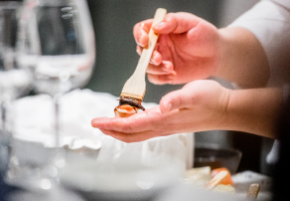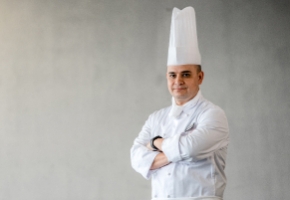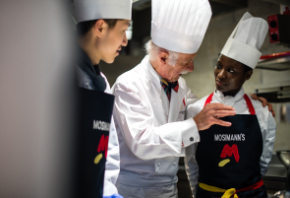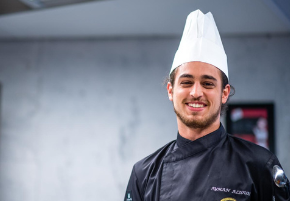- About
- Programs
- Campus Life
- Career Services
- Admissions
- News & Events
- Alumni
How to Grill Corn On the Cob? Easy Steps for Juicy Results
Learn how to grill corn perfectly every time with this easy step-by-step guide. Includes seasoning tips, husk vs. foil methods, and serving ideas!
Key Takeaways
- Grilling caramelizes corn's natural sugars, adding smoky depth and golden char that boiling or steaming cannot achieve.
- To grill corn, select fresh ears, prep and season them, preheat and oil the grill, turn frequently, and finish with toppings.
- Some common mistakes people make when grilling corn include overcooking, failing to soak husks, crowding the grill, or overseasoning, all of which reduce quality.
Corn is one of the most widely eaten grains, valued for its natural sweetness and versatility. Across the world, it appears in many forms—ground into cornmeal for breads and polenta, pressed into oil, shaped into tortillas, or served fresh as baby corn in soups and stir-fries. Even the husks and silk are put to use, from wrapping tamales to brewing teas.
Corn straight from the cob is already worth praising, no matter how it's prepared. Grilling, though, adds a smoky, slightly charred flavor that sets it apart. That's why knowing how to grill corn is such a simple way to turn an ordinary ear into a side that can rival even the main course in flavor.
Why Grilling Corn is a Great Choice
Grilling is a great choice because it brings out the very best of corn: its sweetness and its adaptability.
The high heat of the grill caramelizes corn's natural sugars, intensifying its sweetness and adding layers of flavor. This process also produces the golden-brown char marks that make grilled corn visually appealing while giving each bite a hint of smokiness. It's a transformation that elevates a simple cob into something more complex and memorable.
Grilling also works well when cooking for a crowd. Unlike boiling, which requires a large pot and constant monitoring, a grill can hold several ears of corn at once without much effort. Once placed on the grates, the corn cooks steadily, leaving you free to prepare other dishes or simply enjoy the gathering. This efficiency makes grilling especially practical for barbecues, picnics, or any larger meal.
Corn can be grilled over gas, charcoal, or even an open flame, each imparting slightly different flavors. Gas grills provide convenience and consistency, charcoal adds depth and smokiness, and open flames lend a rustic edge. No matter the setup, the process remains straightforward, which makes grilled corn accessible to almost anyone.
Steps to Grilling Corn
In order to master grilling corn, you must be careful and intentional with each step of the grilling process, from the selection and preparing aspect to the plating in the end. The steps highlighted below form the foundation of successful outdoor cooking.
Start Your Culinary Journey
Learn the art of cooking in a world-class environment
Step 1 – Clean and prep the corn
Start by choosing fresh, high-quality ears. Look for husks that are bright green and slightly damp, with kernels that feel plump and evenly packed under the husk. This will help with the flavor and ensure even cooking.
Whether you decide to keep the husks on or off will influence the outcome of the grilled product. Husks left on create a natural steaming pouch, trapping moisture and protecting the kernels from direct flame. Husks removed expose the kernels directly to the heat, giving you caramelization and the signature grill marks many people love.
If you keep the husks on, soak the ears in cold water for 15–30 minutes before grilling to prevent burning and to boost the steaming effect. For husked corn, strip away the silk carefully and trim any uneven or damaged areas so the corn cooks uniformly.
Step 2 – Season or butter
Lightly brushing oil or melted butter over the kernels prevents sticking and helps flavors adhere during cooking. This coating also ensures even browning as the sugars in the corn caramelize.
Keep initial seasoning simple by using salt, pepper, and butter.
You can layer other flavor variations after grilling. Some popular combinations include:
- Mexican-style: chili powder, lime, and cotija cheese
- Herb blend: garlic powder, paprika, and fresh herbs
- Spicy-sweet: cayenne pepper with a drizzle of honey
- Asian-inspired: soy sauce, sesame oil, and scallions
By seasoning lightly before grilling and adding stronger flavors afterward, you make use of corn's natural sweetness instead of masking it.
Step 3 – Prepare the grill
A hot, clean grill makes all the difference. Preheat to medium-high (200–230°C / 400–450°F) so the heat is strong enough to sear but not so intense that the corn burns. Scrub the grates while they're heating to remove any residue, then oil them with a paper towel dipped in neutral oil. This creates a slick surface that reduces sticking.
If you're using charcoal, create two zones: direct heat for quick searing and indirect heat for finishing without burning. This flexibility lets you adjust as needed, especially when cooking several ears at once.
Step 4 – Place the corn on the grill
Lay the corn directly across the grates so it doesn't roll and to create even grill marks. If you prefer foil-wrapped corn, tuck a bit of butter and seasoning inside each packet to trap steam and balance flavor. Just be sure to space the ears evenly so heat circulates properly—overcrowding can lead to uneven results.
Step 5 – Cook until charred and tender
Timing depends on the method:
- Husk-on: 12–15 minutes total
- Husk-off: 8–12 minutes total
- Foil-wrapped: 15–20 minutes total
Turn the ears every 3–4 minutes so they cook evenly on all sides. For husk-off corn, look for golden kernels with spots of char. For husk-on, the husks should dry out and darken, while the kernels inside steam to tenderness.
A gentle press on a kernel should reveal slight resistance—firm but not mushy.
Step 6 – Add final toppings
After grilling, let the corn rest for 2–3 minutes so it's easier to handle. If you grilled the ear with husks on, peel them back carefully and brush away any remaining silk. Then add your final layer of flavor while the corn is still warm so the toppings melt in and cling to the kernels.
Some common toppings include:
- Lime juice with chili powder and cotija cheese
- Garlic butter with parmesan and black pepper
- Herb butter with rosemary, thyme, and sea salt
- Smoked paprika with olive oil and feta
- Sweet-spicy glaze with honey and sriracha
Common Mistakes to Avoid
Grilling is a cooking technique, not just a matter of tossing food on the grates and waiting. If any step in the process of grilling corn is skipped or rushed, the results can easily fall short.
Some common mistakes that can ruin grilled corn include:
- Overcooking the corn: Cooking too long or with excessive heat dries out the kernels. Corn should stay slightly firm and juicy, so monitor closely and test for doneness often.
- Not turning frequently enough: Leaving corn stationary leads to uneven cooking and burned spots. Turning every 3–4 minutes ensures even heat distribution and balanced charring.
- Skipping seasoning or using too much oil: Light seasoning highlights corn's natural sweetness, but too much oil can cause flare-ups, bitter flavors, and a greasy texture.
- Failing to prep the husks correctly: Grilling with husks that haven't been soaked can cause them to burn before the kernels are cooked through. A short soak adds protection and steam.
- Crowding the grill: Placing too many ears at once restricts airflow and results in uneven cooking. Give each ear enough space to cook properly on all sides.
Perfecting Your Grilled Corn
In order to properly grill corn, you need technique to control heat, precise timing to avoid overcooking, and the knowledge to choose quality ingredients. At Culinary Arts Academy Switzerland (CAAS), students refine all these essentials through hands-on training that spans everything from simple side dishes to the advanced methods behind complex culinary creations.
Join our Bachelor's in Culinary Arts program and prepare for success in professional kitchens around the world. Through our culinary courses and with the guidance of experienced chefs, you'll develop a foundation that blends classical training with modern innovation.
At CAAS, we'll equip you with the judgment and skill to elevate every course, giving even the simplest ingredients the attention they deserve.
Frequently Asked Questions
Do you have to soak corn before grilling?
Soaking is only necessary when grilling corn in husks, in which case 15-30 minutes in cold water prevents burning and creates steam.
How long should you grill corn in the husk?
Grill husked corn for 12-15 minutes total, turning every 3-4 minutes until husks are dry and slightly blackened.
Can you grill frozen corn on the cob?
Yes, you can grill frozen corn on the cob. Thawing first, however, is usually preferred for better texture and flavor.
Interested in becoming a world-class chef? Learn more about Culinary Arts Academy Switzerland. Download our brochure.




















